Plugins
WARNING
This feature is in beta and we might change the API as we develop it.
These docs are in beta too, so please ask for more information when you need it.
Overview
Plugins are a way to extend the functionality of Avo.
Light layer
We are in the early days of the plugin system and we're still figuring out the best way to do it. This is why we have a light layer that you can use to extend the functionality of Avo.
This means we provide two hooks that you can use to extend the functionality of the Rails app, and a few Avo APIs to add scrips and stylesheets.
Register the plugin
The way we do it is through an initializer. We mostly use the engine.rb file to register the plugin.
# lib/avo/feed_view/engine.rb
module Avo
module FeedView
class Engine < ::Rails::Engine
isolate_namespace Avo::FeedView
initializer "avo-feed-view.init" do
# Avo will run this hook on boot time
ActiveSupport.on_load(:avo_boot) do
# Register the plugin
Avo.plugin_manager.register :feed_view
This will add the plugin to a list of plugins which Avo will run the hooks on.
Hook into Avo
module Avo
module FeedView
class Engine < ::Rails::Engine
isolate_namespace Avo::FeedView
initializer "avo-feed-view.init" do
ActiveSupport.on_load(:avo_boot) do
Avo.plugin_manager.register :feed_view
# Add some concerns
Avo::Resources::Base.include Avo::FeedView::Concerns::FeedViewConcern
# Remove some concerns
Avo::Resources::Base.included_modules.delete(Avo::Concerns::SOME_CONCERN)
# Add asset files to be loaded by Avo
# These assets will be added to Avo's `application.html.erb` layout file
Avo.asset_manager.add_javascript "/avo-advanced-assets/avo_advanced"
Avo.asset_manager.add_stylesheet "/avo-kanban-assets/avo_kanban"
end
ActiveSupport.on_load(:avo_init) do
# Run some code on each request
Avo::FeedView::Current.something = VALUE
end
end
end
end
endHooks
-> avo_boot
The avo_boot hook is called when the parent Rails application boots up. This is where you can register your scripts and stylesheets and also add your functionality to Avo.
We use it heavily to add our own concerns to the Avo::BaseResource and Avo::BaseController classes and even extend the Avo::ApplicationController class.
-> avo_init
The avo_init hook is called on every request done inside Avo. You can use this hook to attach some code to the Avo::App.context object or do other things.
INFO
We don't use it as much in our plugins as we do in the avo_boot hook.
Avo AssetManager
We use the AssetManager to add our own asset files (JavaScript and CSS) to be loaded by Avo. They will be added in the <head> section of Avo's layout file.
It has two methods:
-> add_javascript
Avo.asset_manager.add_javascript "/avo-kanban-assets/avo_kanban"This snippet will add the /avo-kanban-assets/avo_kanban.js file to the <head> section of Avo's layout file.
-> add_stylesheet
Avo.asset_manager.add_stylesheet "/avo-kanban-assets/avo_kanban"This snippet will add the /avo-kanban-assets/avo_kanban.css file to the <head> section of Avo's layout file.
Using a middleware to surface asset files
One tricky thing to do with Rails Engines is to expose some asset files to the parent Rails app. The way we do it is by using a middleware that will serve the files from the Engine's app/assets/builds directory.
So app/assets/builds/feed_view.js from the feed_view engine will be served by the parent Rails app at /feed-view-assets/feed_view.js with the following middleware added to your engine.rb file.
module Avo
module FeedView
class Engine < ::Rails::Engine
isolate_namespace Avo::FeedView
initializer "avo-feed-view.init" do
ActiveSupport.on_load(:avo_boot) do
Avo.plugin_manager.register :feed_view
end
end
config.app_middleware.use(
Rack::Static,
urls: ["/feed-view-assets"], # 👈 This is the path where the files will be served
root: root.join("app", "assets", "builds") # 👈 This is the path where the files are located
)
end
end
endINFO
Avo doesn't compile the assets in any way, but just adds them to the layout file. This means that the assets should be compiled and ready for the browser to use them.
We use jsbundling-rails with esbuild to compile the assets before packaging them in the gem file.
Please check out the scripts we use.
Create your own plugin
We don't yet have a generator for that but what we do is to create a new Rails Engine and add the plugin to it.
- Run
rails plugin new feed-view - Add the plugin to the
engine.rbfile - Register the plugin to the
lib/avo/feed_view/engine.rbfile - Optionally add assets
- Add the plugin to your app's
Gemfileusing thepathoption to test it out
 Friendly.rb - Your friendly European Ruby Conference
Friendly.rb - Your friendly European Ruby Conference